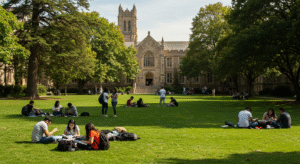These days, we hear a lot about people sending their children to study abroad in the US. But when you calculate the actual cost, you can't help but be shocked. 200 million won per year for 4 years... It's dizzying to think about. Let's take a look at whether this huge investment is really worth it, or whether there are smarter choices we're missing.
Let's look at it based on cold numbers and reality, rather than emotional judgment.
index
- The Price Tag of the American Dream
- The Reality of Soaring Education Costs
- The Cold Reality of Studying Abroad in the U.S. in Numbers
- Will a loan solve it? The swamp of debt
- Studying in the US from an Investment Perspective
- Check out some smart alternatives
- Presenting realistic judgment criteria
- Choose values, not brands
1. The Price Tag of the American Dream
Many parents plan to send their children to study in the United States for a bright future, but are often surprised by the costs, which are much higher than expected.
The basic cost is about 80,000 to 100,000 dollars per year, or about 120 to 150 million won. If you add up not only the tuition but also the living expenses, textbooks, insurance, visa costs, and airfare, the total for four years comes to 500 to 700 million won.
This amount can have a significant impact on your family’s financial planning, especially when unexpected events such as currency fluctuations or rising living expenses can add to the burden.
Studying abroad in the United States offers valuable experiences and opportunities, but it requires careful planning and preparation, as one choice can have a significant impact on your entire family's finances.

2. The reality of rising tuition costs
2-1. The phenomenon of ‘price collusion’ among universities
2-2. The hidden danger of exchange rates
3. The harsh reality of studying abroad in the US in numbers
3-1. Analysis of university costs by tier
🏆SKY-level private universities (MIT, Harvard, Yale, Stanford, etc.)
🎓 Compare Tuition Costs at Top Private Universities in the US 2025
| University name | Tuition | Dormitory + Meals (Room & Board) | Other expenses (Fees, etc.) | Total Annual Cost (USD) | Total annual cost (KRW) | Total cost for 4 years (KRW) |
|---|---|---|---|---|---|---|
| Harvard University | $56,550 | $21,700 | $1,000 | $79,250 | About 110.95 million won | About 438 million won |
| Stanford University | $62,000 | $20,700 | $1,000 | $83,700 | About 117.18 million won | About 468.72 million won |
| Yale University | $64,700 | $20,400 | $1,000 | $86,100 | About 120.54 million won | About 482.16 million won |
| Princeton University | $59,710 | $21,250 | $1,000 | $81,960 | About 114.74 million won | About 458.96 million won |
| Columbia University | $72,650 | $21,720 | $1,000 | $95,370 | About 133.52 million won | About 534,080,000 won |
| Boston University | $69,870 | $19,970 | $1,502 | $91,342 | About 127.88 million won | About 511.52 million won |
| MIT | $64,310 | $19,010 | $3,000 | $86,320 | About 120.84 million won | About 483,360,000 won |
📌 reference:Other expenses include health insurance, textbooks, personal expenses, etc. and may vary depending on the university and student's choice.
🎓 Compare the top private colleges in the US and Boston University's high-cost majors in 2025
| University name | High-Tuition Majors (Undergraduate) | Annual Tuition (USD) | Annual tuition (based on KRW 1,400) | note |
|---|---|---|---|---|
| Harvard University | Engineering and Applied Sciences (SEAS) | $65,536 | About 91.75 million won | Same tuition regardless of major, additional fees for some labs may apply |
| Stanford University | No major distinction | $67,731 | About 94.82 million won | Same tuition for all undergraduate majors |
| Yale University | Nursing | $69,831 | About 97.76 million won | Includes integrated undergraduate/graduate courses |
| Princeton University | No major distinction | $65,210 | About 91.29 million won | Same tuition for all undergraduate majors |
| Columbia University | No major distinction | $72,650 | About 117.1 million won | Same tuition for all undergraduate majors |
| Boston University | No major distinction | $69,870 | About 97.82 million won | Little difference in tuition between undergraduate majors |
| MIT | No major distinction (focused on engineering majors) | $64,310 | About 89.93 million won | Same tuition for all majors, additional internship fee may apply for engineering/CS |
Summary Points:
-
Most top universities offer undergraduate courses regardless of major. Fixed tuitionlevy.
-
Engineering disciplines using experimental and technical equipment Majors (especially MIT, Harvard SEAS, Stanford, etc.) have fees for lab use and fieldwork. Additional costsThis can stick.
-
Columbia Universityhas the highest overall tuition, and MIT is relatively reasonable, but living expenses, etc. are separate.
Top 5 Most Expensive Colleges in the US
-
Harvey Mudd College
- characteristic: It is a top liberal arts college specializing in engineering, math, and science. When purely based on tuition, it almost always ranks first in the entire United States.
- Estimated Cost: The total cost (including dormitory, meals, etc.) exceeds **$93,000 (approximately 128 million won) per year**.
-
University of Southern California (USC)
- characteristic: A large, research-intensive private university located in Los Angeles, California. It is considered one of the most expensive schools, especially when considering the total cost of attendance.
- Estimated Cost: The total cost is close to **$95,000 (approximately 131 million won) per year**.
-
University of Pennsylvania (UPenn)
- characteristic: It is an Ivy League university and is famous for its world-class business school, the Wharton School.
- Estimated Cost: The total cost exceeds **$92,000 (approximately 127 million won) per year**.
-
Columbia University
- characteristic: As it is an Ivy League university, and because of its geographic advantage of being located in Manhattan, New York, the center of the world, the cost of living is high, making the total cost very high.
- Estimated Cost: The total cost exceeds **$93,000 (approximately 128 million won) per year**.
-
Brown University
- characteristic: It is an Ivy League university famous for its liberal academic culture. It is characterized by an 'open curriculum' in which students design their own educational courses.
- Estimated Cost: Total cost $91,000 per year (about 126 million won) It's a level.
3-2. Another trap called living expenses
💰Annual living expenses breakdown:
• Dormitory Fee: $15,000-$20,000
• Food expenses: $6,000-$8,000
• Textbook cost: $1,000-$2,000
• Personal allowance: $3,000-$5,000
• Insurance premium: $2,000-$3,000
• Airfare: 3-5 million won for round trip 2-3 times a year
4. Will it be solved with a loan? The swamp of debt
4-1. The Reality of Student Loans
📊Student Loans Reality check:
• Loan limit: 70-80% of collateral value
• Interest rate: 4-7% per year (floating rate)
• Repayment period: 10-20 years
• Grace period after graduation: 1-2 years
⏰Real-world examples of exchange rate fluctuations:
Loans in 2019: $1 = 1,150 won
As of 2025: 1 dollar = 1,400 won
Increase in exchange rate: 17.4%
Additional burden for a 500 million won loan: approximately 87 million won
💔The reality of people in their 20s and 30s paying off loans
• Repay more than 50% of your monthly salary
• Marriage is delayed by an average of 3-5 years
• Give up on owning a home or postpone it for more than 10 years
• Ask your parents for additional financial help
5. Studying in the US from an investment perspective
Investment vs. Study Abroad with 500 Million Won (2025 Reality)
| Investment/Optional Items | Initial investment | Real value after 4 years | Expected value after 10 years | Non-monetary value and description |
|---|---|---|---|---|
| 🏘️ Major real estate in Seoul (partial share of mid-level apartment or jeonse investment) | 500 million won | About 580 to 650 million won | About 650-800 million won | High stability, short-term profitability may be low |
| 📈 Domestic stocks (focused on ETFs/dividend stocks) | 500 million won | About 550-700 million won | About 6.5 to 1 billion won | Compound income + dividend income possible, but risks exist |
| 🇺🇸 US stocks (S&P500 ETF, etc.) | 500 million won | About 600 to 750 million won | About 750 million to 1.2 billion won | Expected exchange rate gains, long-term rise expected |
| 🎓 Undergraduate study abroad at prestigious American universities (e.g. Boston University, Columbia, MIT) | 500 million won | 0 won (degree assets) | Possibility of earning over 100 million won per year | Depending on your major/job, you can recover your investment within 10 years |
| 🎓 MBA/Professional Study Abroad (Harvard MBA, Law School, etc.) | 500 million won | Obtaining a Professional Degree | Potential for 10+ billion assets within 10 years | Average starting salary of 150-200 million won or more possible, including network assets |
5-1. Why studying abroad in the U.S. is difficult to see as a realistic investment
Studying abroad in the United States is very expensive, and it is often difficult to expect financial returns. Unless you receive a full scholarship, the total cost for four years is approximately 500 million to 700 million won. If you consider this amount as a simple investment, it is a large amount that is not easy to recover.
5-2. The reality of local employment in the U.S. vs. returning to Korea
-
Average Salary at Big Tech Companies in the U.S.: Approximately $150,000~$250,000 (200~300 million)
-
Average annual salary at large Korean companies: 50 to 80 million won
However, the probability of getting a job at a big tech company in the US is very low, less than 5%. Most of them will eventually return to Korea, and if they do not get a job at a top company such as Google, Apple, or Meta, the economic return on investment will likely be negative.
5-3. Calculating the Cool Return on Investment (ROI)
| item | detail |
|---|---|
| Total cost of study abroad | About 500-700 million won (based on 4 years) |
| Salary premium upon returning to Korea | 10-20 million won per year (compared to before studying abroad) |
| Payback period | Approximately 25 to 35 years or more (based on isolation) |
If you had invested the same amount in real estate or stocks, you could expect to double your income within 10 years and 4-5 times within 20 years. From an economic perspective, studying abroad in the U.S. can be seen as a long-term, low-return investment.

6. Look at smart alternatives
6-1. Countries with cost-effective study abroad options
🇩🇪 Germany
school expenses: Almost free (300,000-500,000 won per semester)
characteristic: Universities in countries that run free cafeterias
language: Operates multiple English language courses
🇳🇱 Netherlands
school expenses: 10-20 thousand euros per year
characteristic: Tuition fees cheaper than tulips
merit: English friendly, high level of education
🇨🇦 Canada
school expenses: Half of the US level
characteristic: It's like a neighborhood in the US, but much cheaper
merit: Friendly immigration policy
🇦🇺 Australia
school expenses: 30-40 thousand Australian dollars per year
characteristic: 'Double-job study abroad': studying while working
merit: Working HolidayCan be linked with
6-2. Asia's Rising Powers
🇸🇬 Singapore
characteristic: Small country, big education powerhouse
merit: Asian financial hub, English speaking
expense: 1/3 of the US level
🇭🇰 Hong Kong
characteristic: Education hub where East meets West
merit: International network, bridgehead for entering China
language: Acquire English and Chinese simultaneously
🇯🇵 Japan
characteristic: Opportunity in the Age of Enger
merit: High education level, relatively low cost
culture: Cultural intimacy with Korea
You can get a good education even if you are not in the United States. What matters is not where you learn, but what you learn and how you learn.
7. Presentation of realistic judgment criteria
7-1. Honest self-diagnosis before studying abroad
Our Household Finance Checklist
- Proportion of tuition fees to household assets: If it is above 50%, it is a red flag.
- Living expenses after parents retire: Are you fully prepared?
- Other family members: Is there no one who will sacrifice?
- Emergency Fund: Is it possible to prepare 150% for the expected cost?
- Loan Dependency: If your loan is 50% or more, you need to stock up
Assessing your child's learning ability and adaptability
Honest questions:
- Does my child really like studying?
- Are you the type of person who adapts well to new environments?
- Is your English level good enough to keep up with local classes?
- Are you able to take good care of yourself on your own?
- Do you have a clear career goal?
If you answered 'no' to more than half of these questions, it would be wise to consider other options rather than studying abroad.
The vague expectation that “I’ll just graduate from a good university” is taboo. You need to have a specific major, career path after graduation, and employment plan.
7-2. Wise Choices as Parents
The first thing is to escape from the psychological pressure of “everyone else is sending it.”
Most of the success stories of studying abroad heard at Gangnam moms' cafes are from a very small number of cases.
We must remember that the failures of the silent majority go unheard.
Parents' selection criteria
Children's happiness vs. parents' face
What really matters?
Present satisfaction vs future anxiety
Will you give up the certainty of the present and bet on an uncertain future?
Success of one person vs. stability of the whole family
It's wiser to make choices that make the whole family smile.
The true goal of education is for children to live happy and meaningful lives. That doesn’t necessarily have to be possible only through studying abroad in the United States.
8. Conclusion: Choose values, not brands
Don't be fooled by brand value and miss out on the actual educational content. What's important is what your child learns and what kind of person he or she grows up to be.
Where does the true value of education lie?
A good education is not an expensive education. It's the right education for your child..
Success is not about which college you graduated from. What kind of life do you live?is determined by.
Family happiness is not created by one person's specifications. When everyone laughs together It's done.
The wisdom to compromise with reality but not give up on your dreams
Just because you can't study abroad in the United States doesn't mean you have to give up on your dream of becoming a global talent.
- The development of online education: You can listen to lectures from Harvard and MIT at home.
- Exchange student program: Sufficient experience is possible with just 1-2 semesters
- Foreign companies in Korea: There are many opportunities to gain global experience.
- Entrepreneurship and Personal Branding: An era where ability is more important than academic background
- Various study abroad countries: Other options outside of the US
Let's not sacrifice our family's present for our child's future.
Don't be fooled by the brand, pursue real value.
Let's find happiness for our family, not for others' eyes.
conclusion
Studying abroad in the United States can certainly be a valuable experience, but there is no guarantee that it will always be the best choice. Cost effective, Child's disposition, Family life balance Considering these factors together can lead to a wiser decision.
Nowadays, it is more important than academic background or whether you graduated from a prestigious university. Individual creativity and capabilities, and the ability to find a path that suits you has become more important. In fact, there are more and more cases of people achieving great things in their own way without following the traditional path to success.
The most important thing is, In a direction where both the child and the family can be satisfied and happy It's a decision. Sometimes waiting a little can be a good choice, and there are many high-quality educational opportunities in the country, so you can open up various possibilities.
After all, studying abroad is just one option., as with all education, it is important to remember that the best education is the one that is 'right' for the child.
No more worries about unexpected situations while traveling!
Prepare for life in the United States safely with reliable MyPhysicianPlan health insurance.
Click on the banner below to find out more details and sign up for a solid insurance policy.
⇓⇓⇓
*2025 US Work and Travel (Working Holiday) Crisis! If you miss it, you will have to wait a year – Article Go see
